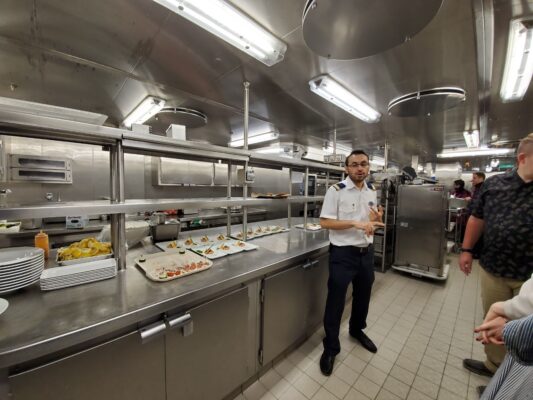Table Of Content

These tanks are designed to have completely airtight seals, which help with odor control. Human waste storage tanks are also located in areas of the cruise ship that are far from areas accessible to passengers. Cruise ships deal with “black water,” which is human waste from toilets, clinics, and critter pens.
Work to Date on Cruise Ship Discharges
Several different agencies and departments actively work to monitor and enforce the rules regarding handling wastewater. Coast Guard, the Environmental Protection Agency (EPA), and the Department of Justice. The critical thing to remember here is that no ship can dump whatever they want, wherever they want. Cruise ships need to follow rules based on where they sail and what sewage they’ve got. As a guide, a four-minute shower uses around 8 gallons, while a toilet flush uses just under 2 gallons.
The Separation of Numerous Types of Waste Water
Now joining the Green Hub program is the Galapagos Islands, where Silversea became the first operator to gain certification in environmental management by diverting all waste from landfill. Initiatives like this allow Royal Caribbean Group to continue to safeguard the delicate ecosystem of the Galapagos for future generations. A solution of caustic soda or seawater sprays from all angles to trap toxic sulfur oxides. All the wastewater onboard is collected and absolutely nothing goes overboard unless it is first run through a treatment plant. Incinerating food waste reduces the volume of the leftover food waste, and that reduces the ship's weight and thus, fuel needed by the ship. If you have been on a cruise ship, you have noticed there is always plenty of uneaten food.
How Much Waste Is Dumped by Cruise Ships?
The cruise line has expanded those efforts, including using point-of-sale data to forecast how much food it will use based on passenger demographics, the itinerary and other information. The company began a three-pronged approach to food waste in 2019, he said, from the point when the lines stock food to after guests throw away what they don’t eat. For many travelers, food is a key part of the cruise experience, with seemingly unlimited options − think buffets − included in the fare. But for all the cuisine passengers enjoy, there is plenty that doesn’t get eaten, and many lines are working to refine their processes for dealing with that waste.
Food
The cruise ship @MSCCrucerosArg discharging its sewers in the port of Punta del Este... Some ships also have wave machines for onboard surfing or 23-foot-tall chambers that blast 100-mile-per-hour winds to simulate a skydive. The increased waste in the ocean adds to the problem of pollution and oxygen depletion in the waters. Added nitrogen and phosphorus allow for algae blooms — which can suffocate coral reefs, manatees, shellfish, and fish.
When you turn on your faucets or flush your toilet waste, you will always receive fresh water. Beyond wastage, cruise lines are also looking at other environmentally-friendly technologies that could be better for the environment and either be more profitable in future, or ensure that people are still happy to cruise. Fuel technology advancements, such as Royal Caribbean’s investment in biofuel, is one of the prominent areas of research.
The ship has an incinerator, as well as a compactor for processing plastic waste. The most visible part of Virgin Voyages’ sustainability program is its reduction of single-use plastics on board, as well as incorporating more sustainable materials for its passengers. From banning plastic utensils to using reusable food containers in restaurants, the goal is to limit how much non-recyclable waste is even produced in the first place. Cruise ships operate within a healthy framework of environmental strategies – demonstrating their dedication to environmental responsibility.
How Much Waste Do Cruise Ships Dump in the Ocean?
However, each ship must follow specific regulatory requirements when disposing of waste, according to the EPA. If just released or dumped into the sea it will be environmentally harmful to marine life and also humans if it washes up upon coastlines. Some of the modern-day mega-cruise ships, including the largest Royal Caribbean cruise ships, can carry well over 6000 passengers and have over 2000 crew members on board. Carnival also acknowledged in 2019 that its vessels had committed environmental crimes and knowingly allowed plastic to be discharged with food waste in the Bahamas. The grewater recycling process involves removing impurities and contaminants from the graywater, making it safe for marine life. This recycling significantly reduces the demand for fresh water on the ship and minimizes the overall volume of wastewater generated.
Today’s cruise ships have advanced waste treatment facilities that use the latest technologies and protocols to manage and dispose of human waste. Ensuring that waste is disposed of in a way that protects passengers and the environment is the primary concern of all cruise ships. Cruise ships are prohibited from dumping untreated sewage or “poop” into the ocean. Cruise ships are equipped with advanced sewage treatment systems that process black wastewater before it is discharged. The handled wastewater should additionally meet extraordinarily strict environmental requirements earlier than it’s launched.
Whereas these cases have occurred, they have been all accidents, and the cruise traces have been penalized in response to strict rules. That is executed to restrict the cruise business’s environmental impression and defend passengers from publicity to disagreeable smells and micro organism. Whenever you flip in your taps or flush your rest room waste, you’ll at all times obtain recent water. Cruise ship toilets utilize vacuum suction systems to effectively remove waste and preserve water consumption. The remaining liquid is disinfected by UV radiation rather than chlorine or other chemicals that would themselves be harmful to marine life.
This resulted in the sewage overflowing from the showers onto the deck floors. This is one reason it is not mixed in with the black water because all these different chemicals could negatively affect the early treatment processes using live bacteria, which could be destroyed by unknown contaminants. These substances can kill marine animals and contaminate seafood if released near coasts, leading to various health complications. In a functional treatment system, the sewage should ideally come out the other side as drinkable water before it is pumped back into the ocean. Royal Caribbean International uses proprietary technology to track how much food is being wasted − by weighing pans of lasagna before and after they are served, for instance − and amend production accordingly.
US cruise ships using Canada as a ‘toilet bowl’ for polluted waste - The Guardian
US cruise ships using Canada as a ‘toilet bowl’ for polluted waste.
Posted: Sat, 09 Jul 2022 07:00:00 GMT [source]
Cruise ships are also required to maintain a certain distance from the shore while discharging sewage. The EPA sampled wastewater from four cruise ships that operated in Alaska during the summer of 2005, to collect information on nutrients in cruise ship wastewater. Championing the Environment With a sustainability journey that began over 30 years ago, Royal Caribbean Group has remained steadfast in its commitment to innovate and advance the solutions necessary for a better future. Cruise ships are entire cities set to sea—the largest ones can carry thousands of people.
Now, she helps over 1 million people per month to plan their perfect cruise holidays. Some cruise lines including Carnival and Royal Caribbean have started to work with artificial intelligence technologies to help manage menu options and food production, in a bid to reduce wastage. Burning anything is never ideal, since you’ll always be releasing some form of harmful gasses. But then neither is dumping anything into the ocean, as it’s not a natural diet for marine animals. A large cruise ship typically has 1.5 tonnes per day of food scraps to dispose of. Once the sewage has been completely processed, it will enter a storage tank until it can be disposed of, either on land or released into the sea at a safe distance from the shore.
Common upkeep and inspections are additionally carried out to make sure that the waste water tanks are sustaining their hermetic seals. To learn more about how Royal Caribbean Group connects people to the world's most beautiful destinations while respecting and protecting ocean communities and ecosystems, visit /SEAtheFuture. Before you take a cruise, consider green travel options instead — or take a look at Friends of the Earth’s Cruise Ship Report Card to see which cruise lines you should adamantly avoid.
Some cruise ship waste streams appear to be well regulated, such as solid wastes (garbage and plastics) and bilge water. Cruise ships use advanced onboard sewage treatment systems to effectively manage and dispose of human waste. These systems comply with strict environmental regulations and ensure minimal harm to marine ecosystems. With the increasing focus on public awareness and education, responsible waste management practices continue to improve in the cruise ship industry. Given their immense scale, modern-day cruise ships carry their own water treatment systems.
Cruise ships treat raw sewage, otherwise known as black water, within a sewage plant in the engine rooms. It goes through a process of filtration, aeration, settlement, and sterilization before being safely released back in permitted sea areas. With more and more cruise ships being built and seemingly getting ever larger it is certainly a question worth looking into because the amount of raw sewage produced equates to thousands of tonnes a year. Any type of plastic disposal is prohibited everywhere at sea, and ships usually have to maintain a Garbage Record Book for keeping up with all garbage discharges.


No comments:
Post a Comment